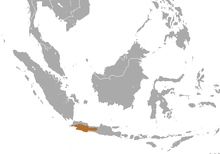Silvery gibbon
| Silvery gibbon[1] | |
|---|---|
 | |
| A female and young | |
| Scientific classification | |
| Kingdom: | Animalia |
| Phylum: | Chordata |
| Class: | Mammalia |
| Order: | Primates |
| Family: | Hylobatidae |
| Genus: | Hylobates |
| Species: | H. moloch |
| Binomial name | |
| Hylobates moloch (Audebert, 1798) | |
 | |
| Silvery gibbon range | |
The silvery gibbon (Hylobates moloch) is a primate in the gibbon family, Hylobatidae. Its coat is bluish-grey in colour, with a dark grey or black cap. Like all gibbons, silvery gibbons lack external tails, have dorsally placed scapulae, and reduced flexibility in their lumbar regions. They have long, curved fingers and very long forelimbs relative to their hind limbs. On average, they reach 8 kg in weight.
The silvery gibbon lives exclusively on the island of Java (Indonesia), where it inhabits deeply hidden portions of the rain forests. It is diurnal and arboreal, climbing trees skilfully and brachiating through the forests. Brachiation is aided by the possession of mobile wrist joints, full rotation of the upper arm, and the ability to lock elbows in suspension. Its diet consists of fruits, leaves, and flowers.
Every three years, on average, the female gives birth to a single young, after a seven-month gestation. The offspring is nursed for about 18 months and lives with the family group until it is fully mature at about eight to ten years old.[2]
Threats and conservation
The silvery gibbon ranks among the most threatened primates. It is listed as Endangered on the 2009 IUCN Red List of Threatened Species,[2] with the population appearing more stable than in a 2004 assessment of the species being Critically Endangered, which suggested there was a 50% chance of the silvery gibbon becoming extinct within the next decade.[3] Habitat destruction on densely populated Java continues to reduce the natural range of the species. Many gibbons are also lost to the illegal pet trade, when adults are hunted so their young can be sold in the markets as pets.[3] There are less than 2,000 silvery gibbons in the wild on eight sites that are considered to be genetically viable for the continuation of the species. There are also a dozen small, non-viable populations. Mount Halimun Salak National Park sustains the largest population of ca. 1,000 gibbons.[3] Other large populations of several hundred are found in the Gunung Ciremai National Park and Gunung Gede Pangrango National Park.[4] In the later there is a Javan Gibbon Centre that rehabilitates ex-captive gibbons.[5]
Several zoos operate silvery gibbon breeding programs. Despite these efforts, the future survival of this species is in question.
Like all gibbon species, the silvery gibbon lives in pairs and stakes out territory that the pair strongly defends; it has relatively small territories of about 42 acres. Females sing to declare their territory several times a day, and if strangers are spotted, the male screams loudly in an attempt to scare them away. The majority of the solo song bouts or scream bouts are produced by the females.[6] The female vocal bouts occur after 0500 hr, with the vocal bout activity peaking around 0600 hr. In contrast, the male vocal bouts primarily occur before 0500 hr.[6] The males are usually very aggressive to others.
Classification
Some experts recognize two subspecies of Hylobates moloch:[7]
- Western silvery gibbon or western Javan gibbon, H. m. moloch
- Eastern silvery gibbon or central Javan gibbon, H. m. pongoalsoni
These subspecies are not recognized by the IUCN Red List.
References
- ↑ Groves, C.P. (2005). Wilson, D.E.; Reeder, D.M., eds. Mammal Species of the World: A Taxonomic and Geographic Reference (3rd ed.). Baltimore: Johns Hopkins University Press. p. 180. OCLC 62265494. ISBN 0-801-88221-4.
- 1 2 3 Andayani, N.; Brockelman, W.; Geissmann, T.; Nijman, V. & Supriatna, J. (2008). "Hylobates moloch". IUCN Red List of Threatened Species. Version 2008. International Union for Conservation of Nature. Retrieved 4 January 2009.
- 1 2 3 "The Silvery Gibbon Project". Retrieved 2007-12-11.
- ↑ Supriatna, Jatna: "Conservation Programs for the Endangered Javan Gibbon", in Primate Conservation, 2006 (21): 155–162
- ↑ The Silvery Gibbon Project: "Conservation Projects", retrieved 20 December 2013
- 1 2 Geissmann, Thomas; Nijman, Vincent (5 February 2009). "Calling in Wild Silvery Gibbons (Hylobates moloch) in Java (Indonesia): Behavior, Phylogeny, and Conservation". American Journal of Primatology. doi:10.1002/ajp.20203.
- ↑ Geissmann, Thomas. "Gibbon Systematics and Species Identification". Retrieved 2006-04-13.
External links
| Wikispecies has information related to: Silvery gibbon |
